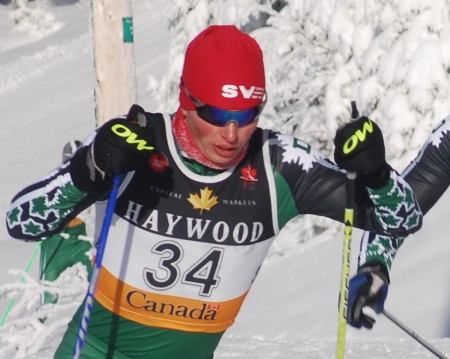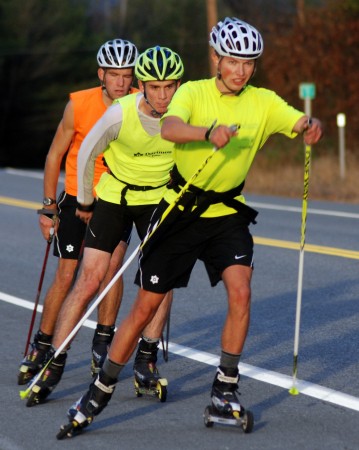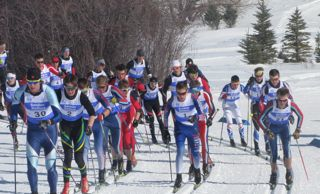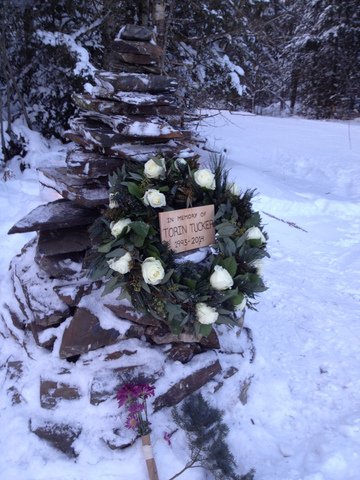“He was having the race of his life,” said Erik Fagerstrom, captain of the Dartmouth men’s ski team.
Torin Tucker, a 20-year-old Dartmouth junior, was skiing in the lead pack in the Craftsbury 50 kilometer on February 1st when he collapsed on a long climb up Sam’s Run. Despite the extraordinary efforts of other racers and emergency responders, no one was able to revive Torin, who died on the trail at the 42 k mark.
Torin had a previously undetected structural anomaly in his heart that caused him to go into cardiac arrest at a time of peak athletic exertion, according to Vermont Deputy Chief Medical Examiner, Dr. Elizabeth Bundock.
This unfathomable loss has touched even those who didn’t know Torin. Many students from other colleges made the trip to Dartmouth on February 5th for the memorial service and candlelight vigil. And nearly 400 skiers came to celebrate and remember Torin at a beautiful evening ski in Craftsbury on February 6th, on the eve of the Dartmouth Carnival.
“Torin was the most genuinely inclusive, kind-hearted and competitive skier out there,” said Annie Hart, co-captain of the Dartmouth’s women’s ski team. “He may not have stood on many podiums, but he was the exemplar of what Nordic skiing should be about.”
Our hearts go out to Torin’s family, friends and teammates as we try to honor his memory and tell this story.
THE RACE
The day of the marathon dawned clear and cold. Temps at the starting line hovered below zero, but were predicted to warm up close to freezing by the race’s end. Nearly 400 racers, including several dozen Dartmouth skiers and alumni, assembled in the Craftsbury stadium to race either 25 or 50 k classic around a challenging 12.5 k loop. The race started slow, according to Fagerstrom, with a lead group of about ten men settling into a steady pace. But by the end of the third lap a core group had broken away: Torin and Fagerstrom, led by former Dartmouth skier and Craftsbury Green Racing Project (CGRP) member Gordon Vermeer, with Tim Reynolds and Eli Enman hanging on close behind.

“Torin was always known for pushing the pace— especially at the beginning— though he often ended up hitting the wall pretty hard,” said Hart. “But this season he was competing at a higher level every single weekend.”
Heading into the final lap of the marathon, Torin was skiing well, sitting between Vermeer and teammate Fagerstrom. Vermeer began to push the pace heading into the steepest hill on Sam’s Run (known to Craftsbury locals as “the manure spreader hill”), the last significant climb before a series of flats and downhill recovery terrain. Torin let a small gap open between himself and Vermeer, and Fagerstrom, third in the pack halfway up the hill, seized the opportunity to pass.
“This was the pinnacle of the race, where we were all exerting ourselves the most,” said Fagerstrom, the eventual race winner, who was working hard to catch Vermeer and create distance between himself and his teammate. The trail left the woods and leveled off slightly, and Fagerstrom describes glancing back briefly and seeing Torin’s green Dartmouth ski team suit about 20 meters behind
“I continued my race, and glanced back multiple times as the course wound its way through the woods and fields,” said Fagerstrom. “I remember finding it very odd that, suddenly, nobody was behind me. Torin had vanished quickly from sight, and I thought to myself that he must have bonked realllllly hard.”
Meanwhile Jamie Chapman, a former Dartmouth rower and current CGRP sculler, was lapped by the lead men in the middle of her third lap. “Torin was behind Erik and just ahead of me at the crest of the hill when I saw him collapse,” said Chapman. “As if there were not a bone in his body.”
Another female skier immediately stopped and bent over Torin, and Chapman shouted that she was going for help. She began to sprint to the next feed station to get a medic, about 2 k up the trail where Sam’s Run meets Ruthie’s Run. Two minutes into her sprint, Chapman passed race spectator Gina Campoli from the Craftsbury Outdoor Center and told her to call 911. Eight minutes of quick people-dodging later, Chapman reached the station and informed workers that a Dartmouth skier had collapsed and didn’t have a pulse. Craftsbury employee and medic Matt Renaud raced back to the scene, already too late to help.
“Everyone acted beyond their normal capacities that day to deal with the completely unimaginable,” said Hart. About 40 seconds after Torin collapsed, former CGRP skier Reynolds arrived and immediately checked for a pulse and respiration. Reynolds began doing CPR as more racers started to ski into the scene. Meanwhile, with no cell phone service in Craftsbury, Campoli and Dartmouth’s Charlotte Gross were skiing as fast as they could backwards on the course, 1 k to Elinor’s farmhouse, to call 911. Arriving first, Gross made the call to Hardwick Rescue, a volunteer ambulance squad located about twenty minutes away.

According to Fagerstrom, the biggest player in the rescue efforts was Joel Bradley of Portland, Maine, a second-year medical resident and former Williams College carnival skier. Bradley arrived on the scene less than five minutes after Reynolds, and immediately took over and led the efforts to save Torin. Several other skier-doctors were present to assist, as were numerous skiers who were not medically trained. Dr. Anne Burnham of Carlisle, MA, tried to encourage later skiers to keep racing and not over-crowd the scene, said John Brodhead, the marathon’s race director.
Joe Holland, Dartmouth Ski Team class of ’84 and an avid marathon skier who has raced the Craftsbury Marathon at least 24 times, was passed by two snowmobiles on the trail.
“I heard the snowmobiles coming with the medics,” said Holland. “When the first one passed me going quickly I thought there must be trouble, when a second one passed I knew it was serious. A couple of minutes up Sam’s Run was the accident scene. Nobody was leaving the area, there were at least six skiers working on him, plus the medics were getting into the rotation. One snowmobile left with a skier to get more help. There was nothing any more of us could do at that point, so we rather sheepishly started moving on and getting back up to speed, asking each other, ‘Who was that skier?’”
Eight kilometers after passing Torin, Fagerstrom crossed the finish line in first and was congratulating second-place finisher Vermeer. Several minutes later he learned that a skier had collapsed on the course, and then received the devastating news that Torin hadn’t survived. Fagerstrom knew he had to tell his coach, Ruff Patterson, who was with the rest of the Dartmouth team at the University of Vermont Carnival at Stowe. “I ran into the garage to make the most difficult phone call of my life,” said Fagerstrom.
REMEMBERING TORIN
The Dartmouth Ski Team returned to Hanover in shock to mourn the loss of their teammate, a humble and outgoing young man with a big smile and perpetually rosy cheeks. In an article in The Dartmouth, Torin’s mother Kathryn Tucker said that he’d always loved the outdoors and had started skiing (both Nordic and alpine) as soon as he could walk.
http://thedartmouth.com/2014/02/06/news/torin-tucker-15-remembered
Torin hailed from Sun Valley, Idaho, where he excelled as a Junior in Rick Kapala’s Nordic program. His high school coach remembers him as an exceptionally open-minded, unself-conscious, and curious individual, according to The Dartmouth. In college Torin studied Arabic and double-majored in economics and physics, possessing incredible drive and determination.

“He had a lot of gifts both as a learner and athlete, and he was dedicated to seeing that his potential was reached,” said Kathryn Tucker in The Dartmouth. “He went after it. Whether it was excelling in academics or sports, there wasn’t a bit of potential he was going to leave on the table.”
Torin’s drive to succeed was balanced with great humility and a kind, joyful spirit. Fagerstrom noted one moment in the Craftsbury marathon that exemplified his personality. “About 1 k before he collapsed, we skied past Charlotte Gross ’16, teammate and friend,” said Fagerstrom. “As we went around her on the right, Torin yelled out something along the lines of “Way to go, Charlotte!”… That’s the type of man Torin was. He had so much joy and support for his friends, family, teammates… We believe these were his last words.”
The Nordic community celebrated Torin at an on-snow memorial in Craftsbury on the Thursday following the marathon. “It was important for the team to go back up there, together,” said Cami Thompson Graves, Head Coach of the Dartmouth women’s team. According to Hart, “an unbelievable turnout” gathered in the stadium skied slowly, in silence, out to the point on Sam’s Run where Torin died, now marked with a stone cairn built by the Center. As the sun set, Fagerstrom spoke briefly about the race, and Torin’s teammates placed a wreath on the cairn. Then hundreds of skiers returned along the remaining 8 k of the marathon course that Torin could not finish.
“I’m not usually the religious type,” said Hart, “but the sky that evening was absolutely unbelievable and it’s hard for me to fathom that Torin wasn’t in some way responsible.”
EMERGENCY RESPONSE AND ATHLETE SCREENING
Given the hundreds of thousands of skiers who compete in marathons worldwide, Torin’s untimely death has raised questions about safety in the ski racing world. Do we need more extensive emergency response plans at race venues? Can increased cardiac screening for young athletes help detect heart anomalies like Torin’s and prevent fatalities?
The New England Nordic Ski Association (NENSA) issues no single standard of safety protocol for event sites, said John Brodhead, Race Director of the Craftsbury marathon. Since the marathon first began in the 1980s, Craftsbury has developed its own extensive response plan. In an area without cell service, Craftsbury takes communication very seriously, utilizing at least 40 radios among staff and volunteers. The Center always has a doctor on-site at races, according to marketing director Sheldon Miller.
Every year Brodhead recruits volunteers and staff to work as marshals and medics out on the marathon course. He’s also requested that Hardwick Rescue be on-site at the race, but the entirely volunteer-staffed ambulance squad has declined. Given the suddenness of Torin’s passing, even if an ambulance had been located several miles away via dirt road at the start/finish line, it would have arrived too late.
But Brodhead plans to keep improving Craftsbury’s ability to handle race emergencies. “We’re definitely revisiting some of our internal safety policies in light of this tragedy,” said Brodhead.
According to NENSA Executive Director Zach Stegeman, Brodhead and his team do an admirable job. “Craftsbury has a robust medical and emergency response plan that NENSA uses as an example for venues hosting NENSA programs,” said Stegeman.
As for preventing sudden cardiac death (SCD), there are few experts on this subject, according to Dr. Jim Carothers, an emergency physician with an interest in sports medicine. Torin Tucker was born with an abnormal coronary artery, an undetected condition that caused him to go into cardiac arrest at 42 k.
Even a screening electrocardiogram (EKG) would likely not have picked up Torin’s abnormality, said Dr. Carothers, and in any case is not required for U.S. athletes in pre-participation physicals. While some athletes with coronary artery anomaly may experience symptoms like chest pain, sudden cardiac death is typically, and tragically, the condition’s presenting sign.
SCD in young athletes is thankfully rare, especially compared with teen driving fatalities (more than 1 in 3 teenage deaths are caused by car crashes, according to the CDC)
Much of the literature on SCD and sports medicine comes from Italy, where EKGs are required for athlete pre-participation and have been shown to prevent incidence, said Dr. Carothers. One prominent study by Basso et al (in the Journal of the American College of Cardiology) estimates that “the prevalence of athletic field deaths to be 0.5 out of 100,000 per year in high-school-age athletes in the U.S. and 1.6 out of 100,000 per year in competitive athletes in Italy.”
But Dr. Carothers thinks “it is nearly impossible to give a real estimate on prevalence of SCD among athletes. There is a huge disparity in the prevalence estimates which, to me, makes them almost irrelevant.”
Some sources estimate that coronary artery anomalies occur in about 1% of the general population, though in most cases, the condition is only fatal under extreme athletic training.
According to the Sudden Death Committee of the American Heart Association, coronary anomalies cause 19% of deaths in athletes. However, the same study also qualifies that “coronary artery anomalies are some of the most confusing, neglected topics in cardiology.”
Dr. Carothers urges athletes and their parents not to dismiss any unusual symptoms of distress during training. “Athletes with a similar condition [to Torin’s] may experience chest pain, palpitations, lightheadedness, or even pass out with exertion,” said Dr. Carothers. “They need to be taken seriously by their doctors and at least receive an EKG, and possibly be referred for an echocardiogram and further testing.”
When people are identified with a coronary artery anomaly, doctors will often severely limit their exercise activity, since ”the greatest incidence of sudden death occurs during heavy physical exertion.”
***
Remembering Torin Tucker on the final lap of the Craftsbury marathon, we can only imagine the extraordinary stress that his heart experienced. But we can also take solace that “at the end, Torin was doing what he loved, alongside people who he loved and who in return, loved him” – as the Dartmouth captains wrote in their open invitation to the on-snow memorial.
Perhaps this inconceivable loss gives us renewed gratitude for our lives and our health, for the fresh snow falling on the Northeast, and makes us closer to family and friends. Perhaps we’ll think of Torin when we glide over the trails or survive the intensity of a ski race.
“Torin was having the race of his life,” said Fagerstrom, “one of those days that ski racers cherish because of the rarity of having all the pieces fall into place. Great skis, great venue, great weather, and the ability to really push your limits. With the discovery of his heart defect, I think it’s fair to say that he literally pushed himself harder that day than he ever had before. And that is a beautiful thing.”
About the Author: Diana Sabot Whitney, Dartmouth Ski Team class of ’95, is a writer and yoga teacher in Brattleboro, Vt. She worked for six years at the Craftsbury Outdoor Center and at one point helped run the Craftsbury Marathon. Please contact her with any questions at diana@coreflowyoga.com





One comment
olivia
February 14, 2014 at 10:03 pm
Great article. Answers all the questions that we needed to know, to process the tragic loss of Torin. Heartfelt condolences to his parents/family, coaches, teammates/friends…